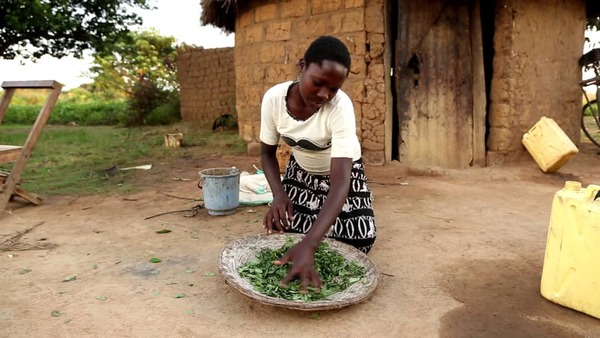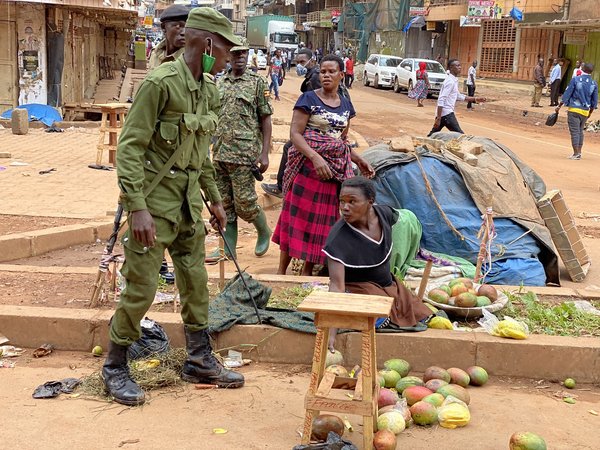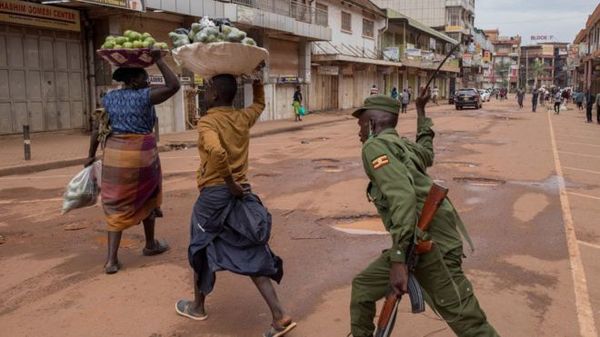Vendor preparing street food (potato chips) for her clients in Wandegeya Market. Kampala, Uganda.
Photo credit: Nobert Petro Kalule.
** This publication is now available in non-colonial African languages: Amharic, Arabic, Ndebele, Shona, Swahili and Wolof **
The recently ratified African Continental Free Trade Area (AfCFTA) looms over Africa. An initiative of the African Union, this mega free trade deal aims to consolidate African markets, boost trade between African countries, and ultimately encourage and reinforce regional integration. The proponents of AfCFTA say it will transform the continent into an economic powerhouse. But, let’s focus on just one category of the population, one that is pre-eminent in agriculture: what does this trade deal mean for African women and their role in the continent’s food production and trade?
Free trade deals are not new to Africa
The AfCFTA pursues the same goals of trade deals that African countries have engaged with in recent decades, but unfolds them now on a much broader scale . It is the continental extension of a corporate driven trade agenda previously imposed on distinct African blocs through numerous trade and investment deals and processes.
In 2000, the United States approved and launched the Africa Growth and Opportunity Act, a unilateral policy that allows Sub-Saharan African nations duty-free access to the US market. This duty-free access extended to over 6000 items including textiles, apparel, footwear, foods, flowers and other products. A selected group of African countries were considered eligible depending on their compliance with US requirements.1 (see Annex 1: AGOA eligibility requirements)
However, twenty years after its launch, AGOA has had little success. Only three African countries – Angola, South Africa and Nigeria – have been fully integrated to this scheme. AGOA exports from Africa to the US have declined rather than grown, from $68.2 billion in 2011 to $23.2 billion in 2014.2 But not ready to call it a day, the Trump administration is currently moving into a new phase of bilateral trade deals with sub-Saharan Africa, and it has started with Kenya. Pundits say that the US-Kenya deal will be modelled on the very harsh and hotly contested US-Morocco deal.
As for Europe, ever since independence, the African, Caribbean and Pacific countries collectively dealt with the European Union under framework agreements. First was the Yaounde Declaration followed by the Lome Conventions I-IV and the Cotonou Partnership Agreement. In sub-Saharan Africa, the Economic Partnership Agreements (EPAs) have been organised along sub-regional fault lines. However, only interim agreements have been finalised so far and few of them are operational.
The European Free Trade Association (EFTA) – uniting Switzerland, Norway, Iceland and Lichtenstein – has also pushed its own FTAs with African partners. These are very much modelled on the comprehensive FTAs that other Western powers like the US and EU favour.
Japan and China, on the other hand, have not negotiated trade deals per se in Africa. They have nonetheless promoted specific investment and aid agreements with individual African countries and the African sub-regional blocs.
Within Africa itself, formal internal trade has been historically low these past decades, accounting for only 2 per cent of the total value of imports and exports. This is precisely what the African CFTA aims to address.3

Teenage girl sorting green leafy vegetables in Gweri Sub-county, Soroti district, Uganda; Photo credit: Nobert Petro Kalule
Women and trade in Africa: impacts so far
It is important to bear in mind that a large part of trade within Africa, both within countries and across borders, is informal. Figures are hard to come by but the general picture is that it accounts for 30-40% of trade within Africa.4 In countries like South Africa, where 40 percent of people working in trade are informal, almost 70 percent of this exchange is in food trade.5 The trend is similar for the rest of the continent: a big part of this trade deals with food and other agricultural products. Women are the main group concerned, who, in rural areas, also contribute close to 60 percent of the labour force in agriculture and up to 80 percent in total food production. (See Box 1: Women in agriculture in Africa)
Women in agriculture in Africa
Women’s time-use in agriculture varies by crop, production cycles, age and ethnic groups but weeding and harvesting are generally women’s duties and also includes a higher proportion of unpaid household responsibilities related to preparing food and collecting fuel and water. Their participation in rural labour markets varies across regions, but invariably, women are still mostly unpaid, seasonal and part-time workers who are often times paid less than men for the same amount of work. Their presence is highly registered in the fruit, vegetable and cut-flower export sector.
Their activities in the sector typically include producing agricultural crops, tending animals, processing and preparing food, working for wages in agricultural or other rural enterprises, collecting fuel and water, engaging in trade and marketing, caring for family members and maintaining their homes. Most importantly though, is the critical and central role that women play in African seed systems. Women are recognized as the main custodians of seed as they manage the preservation, diversity, selection and storage of seed in most if not all African communities. Many of these activities are not defined as “economically active employment” in national accounts but they are essential to the well-being of rural households.6
The track record of past FTAs in regard to the position of women, addressing their concerns in these processes and subsequent benefits have not been good at all. In fact, feminist critiques of free trade and investment policies and agreements in other regions mesh very strongly with the experiences in Africa.7 Concretely, the key issues include the following:
- At the most fundamental level, FTAs are intimately linked to women’s struggles because they promote the exploitation of cheap labour to extract wealth for export. And women constitute a major part of that labour pool, both paid and unpaid. Ever since the North America Free Trade Agreement was signed between the US, Canada and Mexico in 1993, followed by the establishment of the World Trade Organisation in 1995, trade and investment deals have served to universalise an economic model based on these standards, for the benefit of a few, exacerbating gender, class and racial inequalities.8
- The privatisation of seeds, through intellectual property rules, undermines women's access to planting materials and their right to continue the work of seed saving, exchange and experimentation that forms the backbone of agricultural sustainability. In Africa, countries like Algeria, Morocco, Egypt, Tunisia and South Africa have already had their hands tied to agree to the adoption of UPOV standards under trade deals with the US, the EU and the EFTA countries.9 UPOV severely restricts these rights and it opens the door to full-fledged patenting of transgenic seeds at a later stage. And yet women are central to the work of seed saving in Africa.10 If women cannot continue to play their role in seed saving, their socio-economic position, their leverage in decision making processes and ultimately their power as women is compromised and eroded.
- Access to medicines is another grave concern for women that is often challenged by intellectual property rules from trade agreements. South Africa, for instance, has a long history for fighting for and winning the scaling back of drug patenting provisions under bilateral FTAs as well as at the WTO, often for the benefit of the continent. It is crucial to keep this space protected, especially as we face pandemics like Covid-19.11
- The privatisation of water, as a result of services liberalisation, often results in reduced access to water, especially by poorer communities, and increases the burden on women who have to get up earlier or go further to get water for their households. In Africa, countries like Tanzania, Ghana and South Africa have already experienced this first hand in the context of World Bank and International Monetary Fund lending policies. European countries could push for broader investor rights and dispute settlement privileges for their water companies under the next wave of EPA talks with African states.
- Special economic zones, which free trade and investment deals make provisions for and amplify, providing the most intense examples of exploitation of workers, including women. As these zones operate outside the reach of domestic labour or environmental law, they tend to offer the worst working conditions: low pay, poor housing, poor sanitation, all of which breeds a culture of violence against women. Quite a number of countries in Africa host special economic zones, industrial parks and investment corridors where exemptions from land and other regulations already bear down on women quite heavily.12 It would be quite worrisome to see them legitimised and entrenched further through the next generation of FTAs, including the AfCFTA.
- Plantation companies and other agribusinesses, which are incentivised and protected by investment liberalisation rules of trade deals, displace small farmers through land grabs and promote an industrial food system that is unsustainable. Food giants from Nestle to Danone already invest heavily in Africa, operating supply chains for dairy, coffee or ultra-processed foods, both for local and export markets. African supermarket companies like Naivasa in Kenya or Shoprite in South Africa attract Western capital, often through private equity funds that pay handsome returns to their owners. Western food retailers, from Carrefour to Auchan, are also coming in and disrupting local markets.13 Fertilizer and crop chemical giants like Yara, Syngenta, Bayer are keen to make more money from African farmers, despite the disastrous implications for soils, biodiversity and water, resources that women depend on. These pressures to expand the plantation agriculture model, which has been operating in Africa since colonial times, bode poorly for women. Plantation agriculture may promise jobs but these are usually low paying and deny women access to forests, clean water and adequate health services, and are breeding grounds for severe violence against women.14 And it leads to the shocking situation we face today: amidst the havoc of the Covid-19 pandemic, while the World Food Programme is warning of a potential famine of “biblical proportions” in ten countries, half of them in Africa, East Africa celebrates the air lifting of food to Brussels from its Europe-driven horticulture industry!15
Covid-19 has presented government’s across sub-Saharan Africa with the long-awaited pretext to crackdown on informal vendors, regardless that women working in the informal sector provide essential services to their families and communities.  Uganda Police, Local Defense Unit (LDU) and the army in Kampala enforcing a presidential directive to ban public transport and all non-food markets as a means to contain the spread of Coronavirus. Photo credit: Kampala Dispatch  Fruit vendors are chased off the streets of Kampala, Uganda. Photo credit: Badru Katumba/AFP via Getty Images |
Finally, we must recognise and understand the link between free trade and investments agreements, women and militarisation in Africa. Is it by coincidence that the Trump administration is offering its first African FTA to Kenya, the US government’s key partner on counterterrorism in the region?16
Will the AfCFTA be any different?
The AfCFTA as a free trade agreement came into force on 30 May 2019, but the business of trading under the AfCFTA will only begin on 1 June 2020. Confusingly, the negotiation process is still ongoing. Tariff offers have not yet been negotiated and the chapters on services, intellectual property and investment are scheduled to be drawn up later in 2020.
The AfCFTA that has come into force is therefore only a skeleton of what it will be, since the actual substance of the agreement is yet to be agreed upon or finalised. But we do know that expectations are high for AfCFTA to deliver a solid mechanism of trade and investment liberalisation within Africa along the lines seen in other FTAs up to now. These will be tailored to each states’ capacities, for example on tariffs, but advancing a coherent model. The EU is already talking about negotiating a bloc to bloc deal with the AfCFTA once it is complete.
Agriculture and food production– which represents over 55 percent of Africa’s labour force and is the biggest employer of women- is under AfCFTA’s radar. Reason for which AfCFTA wants to open the region’s borders. This would facilitate the dumping of commodities along product-by-product tariff lines that have yet to be agreed. It is also expected to open borders to the free flow of workers, although experience from previous arrangements such as the East African Common Market protocol would suggest that this will only be available for highly skilled workers, not the vast majority of women.17 Worryingly, it will harmonise intellectual property schemes, probably along the lines of UPOV as far as seeds are concerned.
In much of Africa, not only are women the majority of the informal cross border traders, but their trade is mainly in textiles, agricultural products, and consumables which they do as individuals on mainly a weekly basis. They deal in small quantities of goods which makes their border crossing more frequent and ultimately very expensive.18 They have to deal with sexual abuse, lack of knowledge about trade regulations and procedures, limited market information and physical vulnerability.19 The AfCFTA, with its single minded concern with the trade of corporations, will do nothing to help these women.
Another component of the AfCFTA with important impact on women is the Special Economic Arrangements. As expected, the AfCFTA text makes a special provision for state parties establishing special economic arrangements or zones in order to accelerate “development.” But how this will play out remains to be seen but, given the experience with such arrangements around the world, it can’t be less than detrimental to women.
Conclusion
Looking at the history of trade deals in Africa, and struggles around them over the last 30 years, one has to ask: have they strengthened the role of women in society? Have they uplifted women economically, socially, culturally, politically? Do these deals offer good jobs that help women provide for their families, enjoy full health and reproductive rights? And, more broadly, do they support rather than suppress the informal markets that make up 60% of the continent’s economic fabric?
They fail on all these fronts. Actions speak louder than words, and the results of FTAs on the ground betray lip-service from their sponsors to women and other marginalised sectors. The neoliberal core of these trade regimes is omnipresent and in action is a steam-roller driven by the corporate sector. We need a new approach to trade, new strategies based on radically different values altogether: sustainable, collective, de-colonial and not patriarchal, acknowledging and addressing the needs and aspirations of African Peoples.
_____________________________________
1 Kennedy Senelwa, “East Africa exports to the US hit $1bn in the year to September 2018”, The East African, 31 December 2018, https://www.theeastafrican.co.ke/business/East-Africa-exports-to-the-US-hit--1bn-in-the-year-to-September/2560-4914404-12mqfte/index.html
2Timothy Kalyegira, “What failure of AGOA says about Africans”, Daily Monitor, 24 May 2015, https://www.monitor.co.ug/OpEd/Commentary/failure-AGOA-Africans/689364-2727256-i5vcix/index.html
3UNCTAD, June 2019: https://unctad.org/en/pages/PressRelease.aspx?OriginalVersionID=520
4Joachim Jarrreau, et al. "Lifting the lid on the black box of informal trade in Africa," The Conversation, September 2018: https://theconversation.com/lifting-the-lid-on-the-black-box-of-informal-trade-in-africa-102867
5 “Informal trade may hold the key to food security”, Fin24, 20 Oct 2018, https://www.fin24.com/Opinion/informal-trade-may-hold-the-key-to-food-security-20181017
6GRAIN and AFSA, “The real seed producers”, 2018, https://grain.org/e/6035
7A good summary from Latin America is provided by Graciela Rodríguez, “Impacts du libre-échange sur les femmes dans un monde globalisé”, in Alternatives sud, vol. 24, 2017, pp. 147-165. From Asia, please see the excellent materials from Asia-Pacific Forum on Women, Law and Development at https://apwld.org/tag/trade-liberalization/
8 See bilaterals.org website for many accounts, and particularly bilaterals.org, BIOTHAI and GRAIN, “Fighting FTAs”, 2008, https://www.bilaterals.org/fightingFTA-en-Hi.pdf
9See GRAIN, “Trade agreements privatising biodiversity outside the WTO: 2018 update”, https://grain.org/e/6030. UPOV is a French acronym for Union for the Protection of New Plant Varieties, a type of patent regime for seeds.
10See GRAIN and AFSA, “Th real seed producers”, 2019, https://grain.org/e/6035
11 AFTINET, “293 community Groups Call on World Trade Organization to stop other negotiations and focus on access to life-saving medical supplies”, 20 April 2020, http://aftinet.org.au/cms/node/1859
12See for example Eric Toussaint et al., "South Africa’s Special Economic Zones in Global Context," ACCEDE, September 2019: https://accede.co.za/wp-content/uploads/2019/09/ACCEDE%20&%20FES%20Policy%20Working%20Paper%20No.1_WEB.pdf
13See GRAIN, “Supermarkets out of Africa! Food systems across the continent are doing just fine without them”, November 2018, https://grain.org/e/6042
14See RADD, Muyissi Environnment, Culture Radio, Natural Resource Women Platform, GRAIN and WRM "Breaking the silence: Industrial oil palm and rubber plantations bring harassment, sexual violence and abuse against women," March 2019: https://grain.org/e/6164
15 “Tanzania's horticulture industry gets new lease of life”, The Citizen, 14 April 2020, https://www.thecitizen.co.tz/news/business/Horticulture-gets-new-lease-of-life/1840434-5523522-exursez/index.html
16Claire Felter, “What would a US-Kenya trade deal mean?”, Council on Foreign Relations, 21 Feb 2020, https://www.cfr.org/in-brief/what-would-us-kenya-trade-deal-mean. From 2002-2017, US counterterrorism assistance spending in Africa was highest in Kenya ($9.2bn). See Stimson Study Group on Counterterrorism Spending, May 2018, https://www.stimson.org/wp-content/files/file-attachments/CT_Spending_Report_0.pdf
17SEATINI Uganda, “Free movement of workers in the East African Community: Implications for youth employment in Uganda”, 2014, https://www.seatiniuganda.org/publications/research/35-free-movement-of-workers/file.html
18EASSI, “Women informal cross border traders: Opportunities and challenges in the East African Community”, 2012, https://eassi.org/wp-content/uploads/2019/07/Women-Informal-Cross-Border-Traders-Opportunities-and-Challenges-in-the-EAC-Action-research-2012.pdf
19United Nations Conference on Trade and Development, “Borderline: Women in informal cross-border trade in Malawi, the United Republic of Tanzania and Zambia”, 2019, https://unctad.org/en/PublicationsLibrary/ditc2018d3_en.pdf
Teenage girl sorting green leafy vegetables in Gweri Sub-county, Soroti district, Uganda; Photo credit: Nobert Petro Kalule